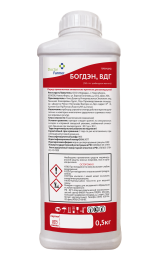Mechanism of action
Tribenuron-methyl penetrates through the leaves and partially through the root system into the plant, blocking the synthesis of the enzyme acetolactate synthase, which is involved in the synthesis of essential amino acids valine, leucine and isoleucine. Suppression of this enzyme blocks cell division, leads to a rapid stop of weed growth, yellowing, and then to their death.
Symptoms of exposure
The appearance of symptoms depends on the type of weed, the stage of growth and weather conditions. The first visible symptoms of herbicide exposure (chlorosis, necrosis, discoloration) appear 3-7 days after spraying.
The speed of impact
The growth of weeds stops a few hours after treatment, and their consumption of nutrients and water decreases. The complete death of weeds occurs 2-4 weeks after spraying.
Less sensitive (field loach) or in a later phase of development, weeds can persist in crops, but their growth is suspended, and they cannot compete with the crop in the consumption of nutrients and water. In warm and humid weather, the action of the herbicide accelerates, while in cool and dry weather it slows down.
The spectrum of action and effectiveness of the drug
Sensitive weeds: hemlock stork, radiant bifora, field buckwheat, speckled hemlock, field sparrow, crow's foot, delicate geranium, dissected geranium, bindweed, pochechuyny mountaineer, field peas, mouse peas, field mustard, Tatar buckwheat, tall goulash, double row (species), medicinal sweet clover, common durnishnik, jaundice leucoid, medium-sized star, clover (species), common krestovnik, common kukol, common flax, field buttercup, alfalfa (species), samosake poppy, white mar, multi-seeded mar, full-time field flower, shepherd's bag, pickle (species), tenacious bedstraw, sorrel sunflower, umbilicus (species), rapeseed, odorless chamomile, wild radish, common violet, field violet, tilted schiritsa, field yarutka, field yaskolka, yasnotka (species).
Medium-sensitive: ragweed, blue cornflower, weedy vetch, datura, drugstore dymyanka, garbage bedbug, curry, spreading quinoa, velcro (species), marjoram, common mother-and-stepmother, small-leaved Canadian, Tatar molokan, milkweed, medicinal dandelion, field osot, white tar, chin (types).
The full list of sensitive weeds is presented in the "Effectiveness Table...".
The period of protective action
It has no soil action, it affects only the weeds that were present at the time of processing. If the recommendations are followed, one treatment is sufficient to effectively suppress dicotyledonous weeds until the end of the growing season, subject to optimal crop development.
Recommendations for use
The most effective application for actively vegetating weeds is in the temperature range from +10 ° C to +25 ° C. It has exceptional selectivity of action against grain crops, exerting the strongest effect during the period of active growth of young weeds.
Annual weeds are effectively suppressed when they are treated in the 2-4 leaf phase, and perennial weeds in the rosette phase. Therefore, when choosing the time of application of the drug, it is preferable to focus on the development of weeds rather than crops. To control late-rising weeds, BOGDEN can be used in the phase of culture entering the tube.
When using the drug in small amounts (up to 15 g / ha), BOGDEN must be used in conjunction with surfactants (surfactants), for example, NEON 99, to increase effectiveness.
It is also recommended to use surfactants when applying the herbicide in adverse weather conditions (low temperatures, drought) and in the fight against medium-sensitive weeds.
Factors affecting efficiency
Crops should be treated under favorable weather conditions.: in clear, warm, windless weather, with sufficient soil moisture.
Low temperatures and drought slow down the effect of the drug. Precipitation that falls within 3-4 hours after application of the drug can significantly reduce the effectiveness of its action against weeds.
Recommendations for use in adverse conditions
It is not recommended to use the drug at a wind speed of more than 5 m/s. During processing, care must be taken to ensure that the drug does not spread to neighboring sensitive crops.
The treatment should not be carried out in case of heavy dew, or if precipitation occurs in the next few hours after application.
Recommended tank mixes
To expand the spectrum of action, increase the effectiveness of suppressing such malignant weeds as field loach and tenacious bedstraw, as well as reduce the risk of resistance, BOGDEN can be used in tank mixtures with preparations containing 2,4-D, for example ELANT (0.45 l/ha) + BOGDEN (12 g/ha).
In the absence of bindweed, it is possible to use a mixture of ELANT (0.3 l/ha) + BOGDEN (10... 15 g/ha). At the same time, it is necessary to take into account the timing of the use of herbicides based on 2,4-D and apply these mixtures no later than the end of tillering. In these tank mixtures, the addition of surfactants is impractical, since a surfactant is already present in the composition of 2,4-D-containing preparations in ether form.
The possibility of resistance
Drug resistance has not been detected. To prevent the occurrence of resistant species, use with drugs with other mechanisms of action should be alternated.
Crop rotation restrictions
It completely decomposes in the soil during the growing season (in the field, the half-life lasts up to 6 days), therefore it does not pose a threat to subsequent crop rotation. In case of loss of cultivated crops, only grain crops should be replanted.
Phytotoxicity
In compliance with the recommendations on the timing and standards of application of the drug, no cases of phytotoxicity in relation to the treated crops have been identified.
BOGDEN can be safely applied in the cold spring, because, unlike hormonal herbicides, it does not cause phytotoxicity even in such weather conditions.
Compatibility
The drug can be used in tank mixtures with most herbicides, insecticides and fungicides applied at the same time. It is not recommended to use mixed with organophosphate insecticides.
Before use, it is recommended to check the components of the tank mixture for compatibility.
Storage conditions
Avoid direct sunlight during storage and observe recommended temperature ranges. After the expiration of the warranty period of storage, the drug must be checked for compliance with the requirements of technical specifications. When establishing compliance, it can be used for its intended purpose.
